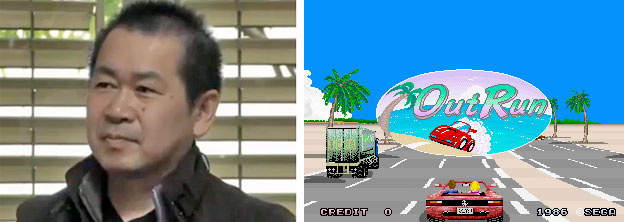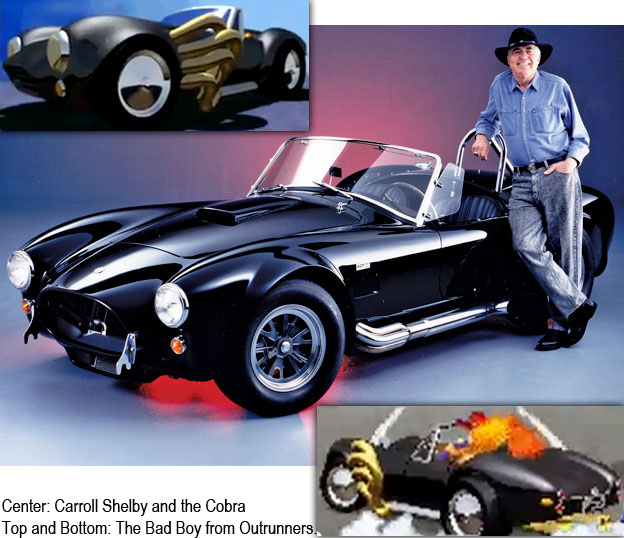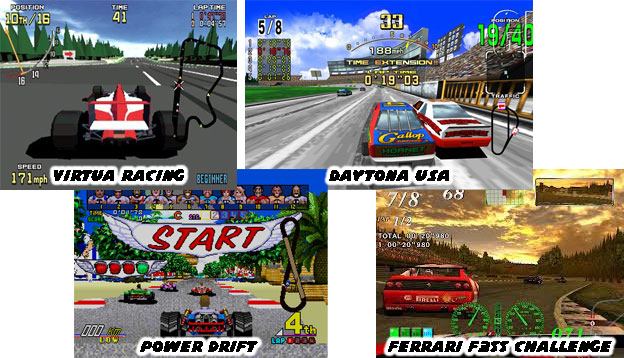Sega has been featured many times on this blog for the various racing games they created. The company actually got into the arcade market before the video screens were integrated into the cabinets. In the early days of the arcade the electronic machines had mechanized components and moving parts, these were known as electro mechanical games. One of their first arcade racing hits was Moto Champ. The title from 1973 featured scale motorcycles on an illuminated track. The opponents moved via magnets under the game screen while the player controlled their own bike via a wire frame attached to some handlebars.
The mechanical games gave way to full video screens not long after. Developers that did not change with the times were forced to shut down. Sega would quickly change from mechanical to digital entertainment. Their first breakout racing game was Monaco Grand Prix in 1980. The game was set with a top down perspective, similar to what Atari had done in their Sprint racing games. It was memorable for the use of color as well as day and night transitions. Racers could only see the portion of the track illuminated by the car headlights, making for some very harrowing action. The game was difficult but rewarding. A year later they created a game that was featured in the film Wreck-it-Ralph. Sega Turbo from 1981 did not actually feature a racer named Turbo, nor did it involve any plot but it did set the template that would make the company famous. The game used a behind the racer POV and followed players through road courses, rewarding them with points as players passed opponents. The game was one of the first to use scaling sprites to create the effect that players were racing bast buildings and countrysides. A few years later Sega used that same technique on more powerful hardware. They created a new legacy with the 1986 game OutRun.

The brains behind the game was Yu Suzuki, the head of Sega's R&D unit AM2. His studio would develop an amazing streak of hits. The games could be seen as a celebration of his love of cars, especially the Ferrari. Suzuki, like so many other Japanese men grew up idolizing the racing cars from the West. They were celebrated on film and television, car enthusiast magazines sprung up and gave a nation cause to debate and discuss the ultimate driving machines. The auto industry in Japan had to increase their pace to help the nation recover from World War II. In order to do that the manufacturers had to try and replicate the things that made the Western companies successful and then improve upon them. They looked at the daily drivers from Europe and the USA and found ways to make small, economical cars for young families. They studied British and German sports cars and began developing contemporary models all their own. Both the family sedan and sports cars would be made more appealing if they could be made domestically and cost less than an import. To help raise their profile the large manufacturers began investing in racing R&D. Toyota formally entered professional motor sports in 1957 but it was Datsun (later renamed Nissan) that got the ball rolling in 1936. Other companies, including Mazda got noticed by building light but powerful engines. The companies began to change the local and international perception of Japanese made autos.
Mr. Suzuki's formative years were during the transition of Japan's auto industry from domestic to international powerhouse. He was around to read about the most innovative racers from Italy, Germany and Britain as they visited the Suzuka Racetrack during the Formula-1 season. He was able to see how well Japan was at recreating the sports cars and duplicating the success of the legendary designs and designers. Take Todd Green's racing Datsun for example. His VQ 35 Datsun roadster was originally created by the Japanese to be a less expensive answer to the Porsche racers. Mr. Green pushed the capabilities of the car and even design to challenge the legendary British AC Cobra.

The Cobra was considered one of the ultimate sport cars. Texan Carroll Shelby (RIP) shoehorned a Ford racing engine into the light frame. The power-to-weight ratio that Shelby had unlocked in the Cobra and later Ford GT-40 went on to capture numerous racing victories and set plenty of speed records. The renamed Shelby Cobra was the envy of car fans around the world. Its styling and bold curves were copied numerous times. The Japanese did not have the Hot Rod revolution that changed car culture in US through the 50's and 60's, they however earn their own driving legacy. The Datsun VQ 35 was joined by the more famous Fairlady Z as cars that would shape post-war Japanese youths and turn them into car fans. Mr. Suzuki and the young designers at Sega were not immune to what car culture was doing to the nation. When Suzuki started he almost instantly began developing a legacy of racing games. OutRun was his most famous contribution but his team never stopped pushing the genre. A spiritual successor to OutRun appeared in 1993. Outrunners was actually developed by sister team AM1 and not by Suzuki. It featured a whole new slew of cars in addition to the trademark Ferrari Testarosa from the original game. The Bad Boy was added to give the Italian car a run for its money. Those that knew of Shelby recognized the inspiration behind the car. The blonde driver wearing a cowboy hat was a clever nod to the Texan.

AM2 did not always focus on realistic racing games, one of their most memorable entries, Power Drift was based on the silliness of go-cart racing. Another, Rad Mobile, demonstrated that storytelling elements could be incorporated through the race itself. The game had players driving in the dark and through the rain in a first person perspective, they actually had to turn on the windshield wipers and lights in order to see the track! The publisher had evolved quickly from the old electro mechanical cabinets they used to make. In fact they began pushing the technology for digital developers. They were among the first to move games away from 2D sprite based graphics to 3D polygons. You can learn how Sega Rally and Virtua Racing changed the genre on my older blogs. The studio had a unique take on the great American pastime of stock car racing with Daytona USA. By the time Super GT was released it could be considered the peak of Yu Suzuki's legacy.

Yu had created a template that defined the arcade racer. The cars were always bright and colorful, they seemed to glide over the road and could be nuanced by drivers into impossibly fast power slides. The control for the majority of the Suzuki-produced racers was nuanced. It was the result of years and years of refinement to bridge the gap from realistic driving to stunt racing. Those that had played through the majority of the games knew that they could be difficult but rewarding as well. The road rockets raced on tracks that would be the envy of the Disney Imagineers. Nothing would have killed a Suzuki racer more than strict realism, his games were gorgeous spectacles. In fact if more tracks in the real world looked liked the ones featured in the Sega racers then there certainly would be no shortage of supporters. The level design of each track had more in common with theme park design and urban planning than driver safety. In some levels towering spires of crystal and steel were the eye-candy off in the distance while roller coasters wound around the track itself. As former 1UP boss guy John Davidson said the races in the Sega games took place on the most utopian day ever. The cities that hosted the races were more breathtaking than any real world city and set a standard that would be hard to top.
The goal of one recent Kickstarter campaign has been to recreate the feel of the Suzuki-produced gems for modern PC gamers. I think that the '90s Arcade Racer did the job well.
The Japanese contributions to the auto industry could not be disputed. From the daily driver to the record breaking racer there was nothing that the nation did not help improve upon. The people had also built a unique car culture over the past century. They embraced foreign cars, sub cultures and icons with sincerity while adding their own unique spin to everything. Manga and animé titles celebrated vehicles and shaped the entertainment industry. Video games did more than their fair share to help popularize driving. Sega went from pioneering electro mechanical games to actual video racing games. Unfortunately not everything that the Japanese did was embraced by the global, or even local community. Even the best laid plans could not save some ambitious games. The next blog will look at one of the most unique racing games ever produced.
Let me know in the comments section please. As always if you would like to sponsor me please visit my Patreon page and consider donating each month, even as little as $1 would help make better blogs and even podcasts!
No comments:
Post a Comment